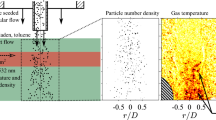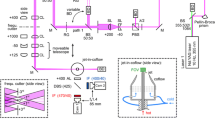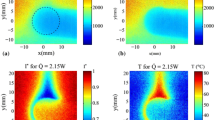Abstract
We present the use of two-colour toluene planar laser-induced fluorescence (LIF) to obtain spatially resolved measurements of the gas temperature (\(T_\mathrm{g}\)) in a particle-laden turbulent flow under sufficiently dense particle loading that the interference from laser interactions with the particles is significant. The effect of the ratio of volumetric flow rates of the particle phase to the gas phase (\(\phi\)) on the accuracy and precision of two-colour toluene LIF thermometry was systematically investigated for three particle materials, alumina, zinc activated zinc oxide (ZnO:Zn) and polymethyl methacrylate (PMMA), each of which has differing interactions with the excitation laser. The PMMA particles were spherical and mono-disperse with diameters of 6 to \(40\, \upmu \hbox {m}\), while the alumina and ZnO:Zn particles had diameters in the range 1–40 \(\upmu \hbox {m}\) and 2–200 \(\upmu \hbox {m},\) respectively. The results show that the accuracy of the gas temperature measurement is insensitive to particle size for the PMMA particles, but dependent on the instantaneous particle loading. Importantly, reliable measurements can be performed in the dense two-way coupling regime, with the measurement being accurate to within 5 °C for \(\phi\) < \(2.5\times 10^{-4}\) for the PMMA particles and for \(\phi<\)\(7.6\times 10^{-4}\) for the alumina and ZnO:Zn particles.
Graphic abstract
















Similar content being viewed by others
References
Abram C, Fond B, Heyes AL, Beyrau F (2013) High-speed planar thermometry and velocimetry using thermographic phosphor particles. Appl Phys B 111(2):155–160. https://doi.org/10.1007/s00340-013-5411-8
Abram C, Fond B, Beyrau F (2015) High-precision flow temperature imaging using ZnO thermographic phosphor tracer particles. Opt Express 23(15):19453–19468. https://doi.org/10.1364/OE.23.019453
Aldén M, Omrane A, Richter M, Särner G (2011) Thermographic phosphors for thermometry: a survey of combustion applications. Prog Energy Combust Sci 37(4):422–461. https://doi.org/10.1016/j.pecs.2010.07.001
Asahi Spectra USA Inc (2018) https://www.asahi-spectra.com/opticalfilters/uv_longpass_filters.html
Cundy M, Trunk P, Dreizler A, Sick V (2011) Gas-phase toluene LIF temperature imaging near surfaces at 10khz. Exp Fluids 51(5):1169–1176. https://doi.org/10.1007/s00348-011-1137-8
Dowling DR, Dimotakis PE (1990) Similarity of the concentration field of gas-phase turbulent jets. J Fluid Mech 218:109–141. https://doi.org/10.1017/S0022112090000945
Elgobashi S (2006) An updated classification map of particle-laden turbulent flows. Springer, The Netherlands, pp 3–10
Faust S, Dreier T, Schulz C (2011) Temperature and bath gas composition dependence of effective fluorescence lifetimes of toluene excited at 266 nm. Chem Phys 383(1):6–11. https://doi.org/10.1016/j.chemphys.2011.03.013
Faust S, Tea G, Dreier T, Schulz C (2013) Temperature, pressure, and bath gas composition dependence of fluorescence spectra and fluorescence lifetimes of toluene and naphthalene. Appl Phys B 110(1):81–93
Faust S, Goschütz M, Kaiser SA, Dreier T, Schulz C (2014) A comparison of selected organic tracers for quantitative scalar imaging in the gas phase via laser-induced fluorescence. Appl Phys B 117(1):183–194. https://doi.org/10.1007/s00340-014-5818-x
Fish WM (2016) Alumina calcination in the fluid-flash calciner, vol. 1, Springer, Switzerland, pp 648–652. https://doi.org/10.1007/978-3-319-48176-0
Fond B, Abram C, Heyes AL, Kempf AM, Beyrau F (2012) Simultaneous temperature, mixture fraction and velocity imaging in turbulent flows using thermographic phosphor tracer particles. Opt Express 20(20):22118–22133. https://doi.org/10.1364/OE.20.022118
Frankel A, Pouransari H, Coletti F, Mani A (2016) Settling of heated particles in homogeneous turbulence. J Fluid Mech 792:869–893. https://doi.org/10.1017/jfm.2016.102
Fuhrmann D, Benzler T, Fernando S, Endres T, Dreier T, Kaiser S, Schulz C (2017) Self-quenching in toluene LIF. Proc Combust Inst 36(3):4505–4514
Grena R (2009) Thermal simulation of a single particle in a falling-particle solar receiver. Sol Energy 83(8):1186–1199. https://doi.org/10.1016/j.solener.2009.02.001
Ho CK, Iverson BD (2014) Review of high-temperature central receiver designs for concentrating solar power. Renew Sustain Energy Rev 29:835–846. https://doi.org/10.1016/j.rser.2013.08.099
Jainski C, Lu L, Sick V, Dreizler A (2014) Laser imaging investigation of transient heat transfer processes in turbulent nitrogen jets impinging on a heated wall. Int J Heat Mass Transf 74:101–112
Kalt PAM, Birzer CH, Nathan GJ (2007) Corrections to facilitate planar imaging of particle concentration in particle-laden flows using Mie scattering, part 1: collimated laser sheets. Appl Opt 46(23):5823
Koban W, Koch JD, Hanson RK, Schulz C (2004) Absorption and fluorescence of toluene vapor at elevated temperatures. Phys Chem Chem Phys 6(11):2940–2945. https://doi.org/10.1039/B400997E
Koban W, Koch JD, Hanson RK, Schulz C (2005) Oxygen quenching of toluene fluorescence at elevated temperatures. Appl Phys B 80(6):777–784. https://doi.org/10.1007/s00340-005-1769-6
Kristensson E, Ehn A, Bood J, Aldén M (2015) Advancements in Rayleigh scattering thermometry by means of structured illumination. Proc Combust Inst 35(3):3689–3696. https://doi.org/10.1016/j.proci.2014.06.056
Kueh KCY, Lau TCW, Nathan GJ, Alwahabi ZT (2018) Non-intrusive temperature measurement of particles in a fluidised bed heated by well-characterised radiation. Int J Multiph Flow 100:186–195. https://doi.org/10.1016/j.ijmultiphaseflow.2017.12.017
Lau TCW, Nathan GJ (2014) Influence of stokes number on the velocity and concentration distributions in particle-laden jets. J Fluid Mech 757:432–457. https://doi.org/10.1017/jfm.2014.496
Lau TCW, Nathan GJ (2016) The effect of stokes number on particle velocity and concentration distributions in a well-characterised, turbulent, co-flowing two-phase jet. J Fluid Mech 809:72–110. https://doi.org/10.1017/jfm.2016.666
Lau TCW, Nathan GJ (2017) A method for identifying and characterising particle clusters in a two-phase turbulent jet. Int J Multiph Flow 88:191–204. https://doi.org/10.1016/j.ijmultiphaseflow.2016.10.002
Lau TCW, Frank JH, Nathan GJ (2019) Resolving the three-dimensional structure of particles that are aerodynamically clustered by a turbulent flow. Phys Fluids 31(7):071702. https://doi.org/10.1063/1.5110323
Longmire EK, Eaton JK (1992) Structure of a particle-laden round jet. J Fluid Mech 236:217–257. https://doi.org/10.1017/S002211209200140X
Luong M, Koban W, Schulz C (2006) Novel strategies for imaging temperature distribution using toluene LIF. J Phys: Conf Ser 45(1):133
Mi J, Nobes DS, Nathan GJ (2001) Influence of jet exit conditions on the passive scalar field of an axisymmetric free jet. J Fluid Mech 432:91–125
Miller F, Koenigsdorff R (1991) Theoretical analysis of a high-temperature small-particle solar receiver. Solar Energy Mater 24(1):210–221. https://doi.org/10.1016/0165-1633(91)90061-O
Miller JD, Slipchenko MN, Mance JG, Roy S, Gord JR (2016) 1-khz two-dimensional coherent anti-stokes Raman scattering (2d-cars) for gas-phase thermometry. Opt Express 24(22):24971–24979. https://doi.org/10.1364/OE.24.024971
Miller VA, Gamba M, Mungal MG, Hanson RK (2013) Single- and dual-band collection toluene PLIF thermometry in supersonic flows. Exp Fluids 54(6):1539. https://doi.org/10.1007/s00348-013-1539-x
Nathan GJ, Kalt PAM, Alwahabi ZT, Dally BB, Medwell PR, Chan QN (2011) Recent advances in the measurement of strongly radiating, turbulent reacting flows. Prog Energy Combust Sci 38(1):41–61. https://doi.org/10.1016/j.pecs.2011.04.001
Papadopoulos G, Pitts WM (1998) Scaling the near-field centerline mixing behavior of axisymmetric turbulent jets. AIAA J 36(9):1635–1642. https://doi.org/10.2514/2.565
Pitts WM (1991a) Effects of global density ratio on the centerline mixing behavior of axisymmetric turbulent jets. Exp Fluids 11(2):125–134. https://doi.org/10.1007/BF00190288
Pitts WM (1991b) Reynolds number effects on the mixing behavior of axisymmetric turbulent jets. Exp Fluids 11(2):135–141. https://doi.org/10.1007/BF00190289
Pouransari H, Mani A (2016) Effects of preferential concentration on heat transfer in particle-based solar receivers. J Solar Energy Eng 139(2):021008–021008-11. https://doi.org/10.1115/1.4035163
Schefer RW, Dibble RW (2001) Mixture fraction field in a turbulent nonreacting propane jet. AIAA J 39(1):64. https://doi.org/10.2514/2.1271
Schulz C, Sick V (2005) Tracer-lif diagnostics: quantitative measurement of fuel concentration, temperature and fuel/air ratio in practical combustion systems. Prog Energy Combust Sci 31(1):75–121. https://doi.org/10.1016/j.pecs.2004.08.002
Semrock (2018) https://www.semrock.com/filters.aspx
Siegel N, Ho C, Khalsa S, Kolb G (2010) Development and evaluation of a prototype solid particle receiver: on-sun testing and model validation. J Solar Energy Eng-Trans ASME 132(2)
Thring MW, Newby MP (1953) Combustion length of enclosed turbulent jet flames. In: Symposium (international) on combustion, vol 4, no 1, pp 789–796. https://doi.org/10.1016/S0082-0784(53)80103-7
Williams A, Pourkashanian M, Jones JM (2001) Combustion of pulverised coal and biomass. Prog Energy Combust Sci 27(6):587–610. https://doi.org/10.1016/S0360-1285(01)00004-1
Yalin AP, Miles RB (1999) Ultraviolet filtered Rayleigh scattering temperature measurements with a mercury filter. Opt Lett 24(9):590
Yaws CL (1994) Handbook of vapor pressure / Carl L. Yaws. Library of physico-chemical property data. Gulf Pub. Co., Houston
Author information
Authors and Affiliations
Corresponding authors
Additional information
Publisher's Note
Springer Nature remains neutral with regard to jurisdictional claims in published maps and institutional affiliations.
The authors would like to acknowledge the financial contributions of the Australian government through the Australian Research Council (Discovery Grant DP180102045) and the Australian Renewable Energy Agency (Grant 2015/RND054).
Appendix
Appendix
The accuracy of the two-colour thermometry is significantly influenced by the strength of the fluorescence signals relative to the noise, as shown in Fig. 9. In particular, because the temperature is inferred from the fluorescence intensity ratio rather than directly from the individual fluorescence intensities, the errors in temperature measurement can be particularly significant where the signal strength of the denominator term, in the present case the blue channel, is on the order of the noise strength. To reduce this effect, we employ two commonly used post-processing techniques – thresholding and smoothing. Here, we investigate the effect of these two technique on the prevalence of errors in the temperature measurement for a single image. To quantify the errors, we first calculate the difference between the measured and actual temperature, \({\varDelta T_\mathrm{dep}}\), on a pixel-by-pixel basis for the entire region of the image that is above the specified threshold. The mean (\(\overline{\varDelta T_\mathrm{dep}}\)) and standard deviation (\(\sigma _{\varDelta T}\)) of this ensemble were then calculated for the case where the jet is unheated, because the actual gas temperature is uniform and known for this case.
Figure 16 presents the effect of the threshold value, \(\epsilon\), on both \(\overline{\varDelta T_\mathrm{dep}}\) and \(\sigma _{\varDelta T}\). The threshold is normalised by \(I_\mathrm{base}\), which is the temporally and spatially averaged fluorescence intensity, within the region \(-0.1 < r/D<\) 0.1, 0.5 \(< x/D < 3\), where the toluene tracer is not mixed with the co-flow. The thresholding procedure was performed separately for each channel, such that the temperature at each pixel was only calculated if the intensity in both channels satisfy their respective threshold requirements. The values of \(I_\mathrm{base}\) correspond to SNR = 38.4 and 19.6 for the blue and red channels, respectively. The results show that \(\overline{\varDelta T_\mathrm{dep}}< 0.1\) °C for \(\epsilon /I_\mathrm{base}>\) 7%, while \(\sigma _{\varDelta T}\) reduces monotonically as \(\epsilon /I_\mathrm{base}\) increases. While the errors in the measured temperature can be further reduced at larger \(\epsilon\), this also reduces the number of usable data points in each image, particularly near to the jet edges (see Figs. 8 and 10). Therefore, as a compromise, a threshold value of \(\epsilon /I_{base}\) of 10% was used for the present investigation. This resulted in pixels with SNR \(\le\) 3.84 or 1.96 for the blue and red channels, respectively, being excluded from the temperature measurement.
Figure 17 presents the influence of smoothing kernel size, N, on (\(\overline{\varDelta T_\mathrm{dep}}\)) and (\(\sigma _{\varDelta T}\)). Here, the smoothing kernel applied to the instantaneous temperature measurements is a \(N\times N\) pixel mean filter. Pixels below the \(\epsilon /I_\mathrm{base}\) threshold were excluded from the smoothing procedure. Each pixel measures a region of cross-section 32.\(7 \times 32.7\, \upmu \hbox {m}\), so that the minimum spatial resolution of the filtered images is 32.7\(\times N\, \upmu \hbox {m}\). A threshold value of 10% was applied to the images before filtering. It can be seen that both \(|\overline{\varDelta T_\mathrm{dep}}|\) and \(\sigma _{\varDelta T}\) decrease as the filter size is increased. Without filtering (i.e. \(N = 1\)), \(\overline{\varDelta T_\mathrm{dep}} = -1.7\) °C, with a standard deviation of 25.7 °C. For all values of \(N \ge\) 9, \(\overline{\varDelta T_\mathrm{dep}}<\) 0.025 °C, with the corresponding \(\sigma _{\varDelta T}\) for \(N = 9\) and 15 being 8.3 °C and 5.7 °C, respectively. While a larger smoothing kernel decreases both \(|\overline{\varDelta T_\mathrm{dep}}|\) and \(\sigma _{\varDelta T}\), this comes at the expense of spatial resolution. Hence, a kernel size of \(9 \times 9\) pixels was chosen because it has a near zero mean error with a relatively low standard deviation, while still preserving a reasonable spatial resolution of \(294\, \upmu \hbox {m}\). As the light sheet thickness for the current experiments is \(\approx 300\, \upmu \hbox {m}\), this results in a roughly cubic measurement volume of \(294 \times 294\times 300 \upmu \hbox {m}\) for each pixel.
Rights and permissions
About this article
Cite this article
Lewis, E.W., Lau, T.C.W., Sun, Z. et al. Luminescence interference to two-colour toluene laser-induced fluorescence thermometry in a particle-laden flow. Exp Fluids 61, 101 (2020). https://doi.org/10.1007/s00348-020-2942-8
Received:
Revised:
Accepted:
Published:
DOI: https://doi.org/10.1007/s00348-020-2942-8






